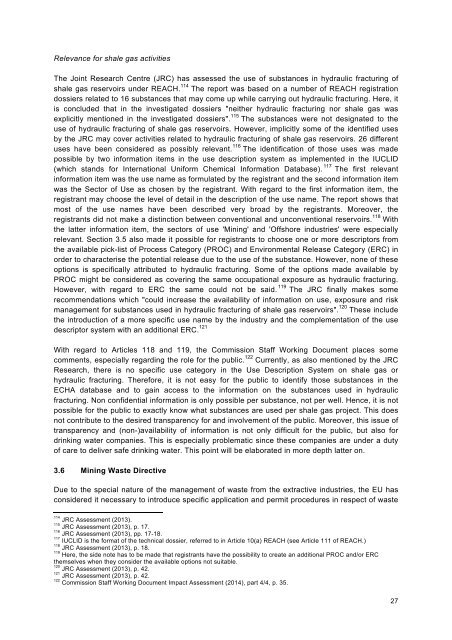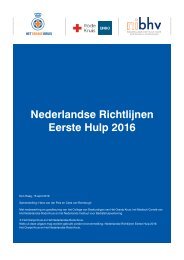Thesis-Anne-Vos-Masters-SBR-and-EU-Law-3
Thesis-Anne-Vos-Masters-SBR-and-EU-Law-3
Thesis-Anne-Vos-Masters-SBR-and-EU-Law-3
Create successful ePaper yourself
Turn your PDF publications into a flip-book with our unique Google optimized e-Paper software.
Relevance for shale gas activities<br />
The Joint Research Centre (JRC) has assessed the use of substances in hydraulic fracturing of<br />
shale gas reservoirs under REACH. 114 The report was based on a number of REACH registration<br />
dossiers related to 16 substances that may come up while carrying out hydraulic fracturing. Here, it<br />
is concluded that in the investigated dossiers "neither hydraulic fracturing nor shale gas was<br />
explicitly mentioned in the investigated dossiers". 115 The substances were not designated to the<br />
use of hydraulic fracturing of shale gas reservoirs. However, implicitly some of the identified uses<br />
by the JRC may cover activities related to hydraulic fracturing of shale gas reservoirs. 26 different<br />
uses have been considered as possibly relevant. 116 The identification of those uses was made<br />
possible by two information items in the use description system as implemented in the IUCLID<br />
(which st<strong>and</strong>s for International Uniform Chemical Information Database). 117 The first relevant<br />
information item was the use name as formulated by the registrant <strong>and</strong> the second information item<br />
was the Sector of Use as chosen by the registrant. With regard to the first information item, the<br />
registrant may choose the level of detail in the description of the use name. The report shows that<br />
most of the use names have been described very broad by the registrants. Moreover, the<br />
registrants did not make a distinction between conventional <strong>and</strong> unconventional reservoirs. 118 With<br />
the latter information item, the sectors of use 'Mining' <strong>and</strong> 'Offshore industries' were especially<br />
relevant. Section 3.5 also made it possible for registrants to choose one or more descriptors from<br />
the available pick-list of Process Category (PROC) <strong>and</strong> Environmental Release Category (ERC) in<br />
order to characterise the potential release due to the use of the substance. However, none of these<br />
options is specifically attributed to hydraulic fracturing. Some of the options made available by<br />
PROC might be considered as covering the same occupational exposure as hydraulic fracturing.<br />
However, with regard to ERC the same could not be said. 119 The JRC finally makes some<br />
recommendations which "could increase the availability of information on use, exposure <strong>and</strong> risk<br />
management for substances used in hydraulic fracturing of shale gas reservoirs". 120 These include<br />
the introduction of a more specific use name by the industry <strong>and</strong> the complementation of the use<br />
descriptor system with an additional ERC. 121<br />
With regard to Articles 118 <strong>and</strong> 119, the Commission Staff Working Document places some<br />
comments, especially regarding the role for the public. 122 Currently, as also mentioned by the JRC<br />
Research, there is no specific use category in the Use Description System on shale gas or<br />
hydraulic fracturing. Therefore, it is not easy for the public to identify those substances in the<br />
ECHA database <strong>and</strong> to gain access to the information on the substances used in hydraulic<br />
fracturing. Non confidential information is only possible per substance, not per well. Hence, it is not<br />
possible for the public to exactly know what substances are used per shale gas project. This does<br />
not contribute to the desired transparency for <strong>and</strong> involvement of the public. Moreover, this issue of<br />
transparency <strong>and</strong> (non-)availability of information is not only difficult for the public, but also for<br />
drinking water companies. This is especially problematic since these companies are under a duty<br />
of care to deliver safe drinking water. This point will be elaborated in more depth latter on.<br />
3.6 Mining Waste Directive<br />
Due to the special nature of the management of waste from the extractive industries, the <strong>EU</strong> has<br />
considered it necessary to introduce specific application <strong>and</strong> permit procedures in respect of waste<br />
114<br />
JRC Assessment (2013).<br />
115<br />
JRC Assessment (2013), p. 17.<br />
116<br />
JRC Assessment (2013), pp. 17-18.<br />
117<br />
IUCLID is the format of the technical dossier, referred to in Article 10(a) REACH (see Article 111 of REACH.)<br />
118<br />
JRC Assessment (2013), p. 18.<br />
119<br />
Here, the side note has to be made that registrants have the possibility to create an additional PROC <strong>and</strong>/or ERC<br />
themselves when they consider the available options not suitable.<br />
120<br />
JRC Assessment (2013), p. 42.<br />
121<br />
JRC Assessment (2013), p. 42.<br />
122<br />
Commission Staff Working Document Impact Assessment (2014), part 4/4, p. 35.<br />
27



